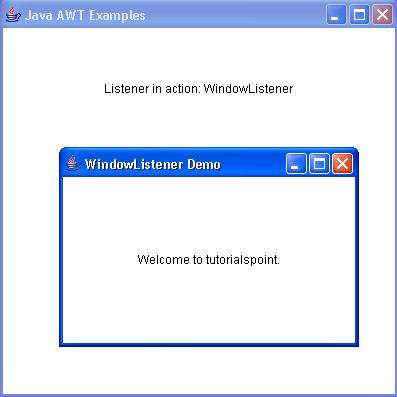
- AWT - Home
- AWT - Overview
- AWT - Environment
- AWT - Controls
- AWT - Event Handling
- AWT - Event Classes
- AWT - Event Listeners
- AWT - Event Adapters
- AWT - Layouts
- AWT - Containers
- AWT - Menu
- AWT - Graphics
AWT - Useful Resources
AWT WindowListener Interface
The class which processes the WindowEvent should implement this interface.The object of that class must be registered with a component. The object can be registered using the addWindowListener() method.
Interface declaration
Following is the declaration for java.awt.event.WindowListener interface:
public interface WindowListener extends EventListener
Interface methods
| S.N. | Method & Description |
|---|---|
| 1 |
void windowActivated(WindowEvent e) Invoked when the Window is set to be the active Window. |
| 2 |
void windowClosed(WindowEvent e) Invoked when a window has been closed as the result of calling dispose on the window. |
| 3 |
void windowClosing(WindowEvent e) Invoked when the user attempts to close the window from the window's system menu. |
| 4 |
void windowDeactivated(WindowEvent e) Invoked when a Window is no longer the active Window. |
| 5 |
void windowDeiconified(WindowEvent e) Invoked when a window is changed from a minimized to a normal state. |
| 6 |
void windowIconified(WindowEvent e) Invoked when a window is changed from a normal to a minimized state. |
| 7 |
void windowOpened(WindowEvent e) Invoked the first time a window is made visible. |
Methods inherited
This interface inherits methods from the following interfaces:
java.awt.EventListener
WindowListener Example
Create the following java program using any editor of your choice in say D:/ > AWT > com > tutorialspoint > gui >
AwtListenerDemo.java
package com.tutorialspoint.gui;
import java.awt.*;
import java.awt.event.*;
public class AwtListenerDemo {
private Frame mainFrame;
private Label headerLabel;
private Label statusLabel;
private Panel controlPanel;
public AwtListenerDemo(){
prepareGUI();
}
public static void main(String[] args){
AwtListenerDemo awtListenerDemo = new AwtListenerDemo();
awtListenerDemo.showWindowListenerDemo();
}
private void prepareGUI(){
mainFrame = new Frame("Java AWT Examples");
mainFrame.setSize(400,400);
mainFrame.setLayout(new GridLayout(3, 1));
mainFrame.addWindowListener(new WindowAdapter() {
public void windowClosing(WindowEvent windowEvent){
System.exit(0);
}
});
headerLabel = new Label();
headerLabel.setAlignment(Label.CENTER);
statusLabel = new Label();
statusLabel.setAlignment(Label.CENTER);
statusLabel.setSize(350,100);
controlPanel = new Panel();
controlPanel.setLayout(new FlowLayout());
mainFrame.add(headerLabel);
mainFrame.add(controlPanel);
mainFrame.add(statusLabel);
mainFrame.setVisible(true);
}
private void showWindowListenerDemo(){
headerLabel.setText("Listener in action: WindowListener");
Button okButton = new Button("OK");
aboutFrame = new Frame();
aboutFrame.setSize(300,200);;
aboutFrame.setTitle("WindowListener Demo");
aboutFrame.addWindowListener(new CustomWindowListener());
Label msgLabel = new Label("Welcome to tutorialspoint.");
msgLabel.setAlignment(Label.CENTER);
msgLabel.setSize(100,100);
aboutFrame.add(msgLabel);
aboutFrame.setVisible(true);
}
class CustomWindowListener implements WindowListener {
public void windowOpened(WindowEvent e) {
}
public void windowClosing(WindowEvent e) {
aboutFrame.dispose();
}
public void windowClosed(WindowEvent e) {
}
public void windowIconified(WindowEvent e) {
}
public void windowDeiconified(WindowEvent e) {
}
public void windowActivated(WindowEvent e) {
}
public void windowDeactivated(WindowEvent e) {
}
}
}
Compile the program using command prompt. Go to D:/ > AWT and type the following command.
D:\AWT>javac com\tutorialspoint\gui\AwtListenerDemo.java
If no error comes that means compilation is successful. Run the program using following command.
D:\AWT>java com.tutorialspoint.gui.AwtListenerDemo
Verify the following output
